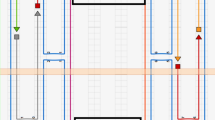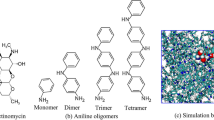Abstract
The present article aims to investigate the ability of a DNA origami nanocarrier to successfully capture a cargo using molecular dynamics (MD) simulation. In addition, the passage of the cargo through the nanocarrier was analyzed by steered molecular dynamics (SMD) simulation. The proposed DNA origami nanocarrier is a nanotube that consists of six double helices in which a positively charged nanocargo was placed. Since the stability of the nanocarrier has been considered one of the obstacles to nanocargo transportation, different cross-sectional areas of the nanocarrier were considered as measures to analyze its structural stability. The results eventually showed that the proposed nanocarrier is able to retain the cargo while maintaining its structural stability. The analysis also revealed that the presence of the cargo increases the structural stability in parts of the nanocarrier. SMD simulation demonstrated that a feasible amount of force is required to separate the cargo and pass it through the nanocarrier, which can provide useful information in the field of smart drug delivery.













Similar content being viewed by others
References
Douglas, S. M., Dietz, H., Liedl, T., Högberg, B., Graf, F., & Shih, W. M. (2009). Self-assembly of DNA into nanoscale three-dimensional shapes. Nature, 459(7245), 414–418.
Seeman, N. C., & Sleiman, H. F. (2017). DNA nanotechnology. Nature Reviews Materials, 3(1), 17068.
Linko, V., & Dietz, H. (2013). The enabled state of DNA nanotechnology. Current Opinion in Biotechnology, 24(4), 555–561.
Kuzuya, A., & Ohya, Y. (2014). Nanomechanical molecular devices made of DNA origami. ACC Chemical Research, 47, 1742–1749.
Hong, F., Zhang, F., Liu, Y., & Yan, H. (2017). DNA origami: Scaffolds for creating higher order structures. Chemical Reviews, 117(20), 12584–12640.
Ramakrishnan, S., Ijäs, H., Linko, V., & Keller, V. (2018). Structural stability of DNA Origami nanostructures under application-specific conditions. Computational and Structural Biotechnology Journal, 16, 342–349.
Kim, Y., & Yin, P. (2020). Enhancing biocompatible stability of DNA nanostructures using dendritic oligonucleotides and brick motifs. Angewandte Chemie International Edition, England, 59(2), 700–703.
Yin, P., Hariadi, R. F., Sahu, S., Choi, H. M. T., Park, S. H., Labean, T. H., & Reif, J. H. (2008). Programming DNA tube circumferences. Science, 321, 824–826.
Andersen, E. S., Dong, M., Nielsen, M. M., Jahn, K., Subramani, R., Mamdouh, W., et al. (2009). Self-assembly of a nanoscale DNA box with a controllable lid. Nature, 459(7243), 73–6.
Zadegan, R. M., Jepsen, M. D. E., Thomsen, K. E., Okholm, A. H., Schaffert, D. H., Andersen, E. S., Birkedal, V., & Kjems, J. (2012). Construction of a 4 Zeptoliters switchable 3D DNA box origami. ACS Nano, 6, 10050–10053.
Kang, J. H., Kim, K. R., Lee, H., Ahn, D. R., & Ko, Y. T. (2017). In vitro and in vivo behavior of DNA tetrahedrons as tumor-targeting nanocarriers for doxorubicin delivery. Colloids and Surfaces B: Biointerfaces, 157, 424–431.
Wiraja, C., Zhu, Y., Lio, D. C. S., Yeo, D. C., Xie, M., Li, W. Q., Zheng, M., van Steensel, M., Wang, L., et al. (2019). Framework nucleic acids as programmable carrier for transdermal drug delivery. Nature Communications, 10, 1147.
Liu, J., Song, L., Liu, S., Jiang, Q., Liu, Q., Li, N., Wang, Z. G., & Ding, B. (2018). A DNA-based nanocarrier for efficient gene delivery and combined cancer therapy. Nano Letters, 18, 3328–3334.
Kiviaho, J. K., Linko, V., Ora, A., Tiainen, T., Jarvihaavisto, E., Mikkil, J., Tenhu, H., Nonappa, N., & Kostiainen, M. A. (2016). Cationic polymers for DNA origami coating—examining their binding efficiency and tuning the enzymatic reaction rates. Nanoscale, 8, 11674–80.
Ijas, H., Hakaste, I., Shen, B., Kostiainen, M. A., & Linko, V. (2019). Reconfigurable DNA origami nanocapsule for pH-controlled encapsulation and display of cargo. ACS Nano, 13, 5959–5967.
Grossi, G., Jepsen, M. D. E., Kjems, J., & Andersen, E. S. (2017). Control of enzyme reactions by a reconfigurable DNA nanovault. Nature Communications. https://doi.org/10.1038/s41467-017-01072-8
Douglas, S. M., Bachelet, I., & Church, G. M. (2012). A logic-gated nanorobot for targeted transport of molecular payloads. Science, 335, 831–834.
Kuzuya, A., & Komiyama, M. (2009). Design and construction of a box-shaped 3D-DNA origami. Chemical Communications, 28, 4182–4184.
Maingi, V., Burns, J. R., Uusitalo, J. J., Howorka, S., Marrink, S. J., & Sansom, M. S. P. (2017). Stability and dynamics of membrane-spanning DNA nanopores. Nature Communications, 8, 1–12.
Lee, J. Y., Lee, J. G., Yun, G., Lee, Ch., Kim, Y.-J., Kim, K. S., Kim, T. H., & Kim, D.-N. (2021). Rapid computational analysis of DNA origami assemblies at near-atomic resolution. ACS Nano, 15, 1002–1015.
Mogheiseh, M., Hasanzadeh Ghasemi, R., & Soheilifard, R. (2021). The effect of crossovers on the stability of DNA Origami type nanocarriers. Multidiscipline Modeling in Materials and Structures, 17(2), 426–436.
Zhang, Q., et al. (2014). DNA Origami as an in vivo drug delivery vehicle for cancer therapy. ACS Nano, 8, 6633–6643.
Keramati, M., & Hasanzadeh Ghasemi, R. (2017). A molecular dynamics investigation of the effects of mutation on prefoldin nano actuator in inhibiting amyloid ˇ42-dimer. Sensors and Actuators B: Chemical, 248, 536–544.
Weiden, J., & Bastings, M. M. C. (2021). DNA Origami nanostructures for controlled therapeutic drug delivery. Current Opinion in Colloid & Interface Science, 52, 101411.
Chi, Q., Yang, Z., Xu, K., Wang, Ch., & Liang, H. (2020). DNA nanostructure as an efficient drug delivery platform for immunotherapy. Frontiers in Pharmacology, 10, 1585. https://doi.org/10.3389/fphar.2019.01585
Jiang, Q., Liu, S., Liu, J., Wang, Z.-G., & Ding, B. (2019). Rationally designed dna-origami nanomaterials for drug delivery in vivo. Advance Material, 31(45), 1804785.
Yoo, J., & Aksimentiev, A. (2013). In situ structure and dynamics of DNA Origami determined through molecular dynamics simulations. Proceedings of the National Academy of Sciences of the United States of America, 110, 20099–20104.
Khosravi, R., Ghasemi, R. H., & Soheilifard, R. (2020). Design and simulation of a DNA origami nanopore for large cargoes. Mol Biotechnol, 62(9), 423–432.
Dastorani, S., Mogheiseh, M., Ghasemi, R. H., & Soheilifard, R. (2020). Modeling and Structural Investigation of a New DNA Origami Based Flexible Bio-Nano Joint. Molecular Simulation. https://doi.org/10.1080/08927022.2020.1797019
Dastorani, S., Hasanzadeh Ghasemi, R., & Soheilifard, R. (2021). A study on the bending stiffness of a new DNA origami nano-joint. Molecular Biotechnology, 63, 1057–1067.
Douglas, S. M., Marblestonen, A. H., Teerapittayanon, S., Vazquez, A., Church, G. M., & Shih, W. M. (2009). Rapid prototyping of 3D DNA-origami shapes with caDNAno. Nucleic Acids Research, 37(15), 5001–5006.
Ghaffari, A., Shokuhfar, A., & Hasanzadeh Ghasemi, R. (2012). Capturing and releasing a nano cargo by Prefoldin nano actuator. Sensors and Actuators B: Chemical, 171, 1199–1206.
Auvinen, H., et al. (2017). Protein coating of DNA nanostructures for enhanced stability and immunocompatibility. Advanced Healthcare Materials. https://doi.org/10.1002/adhm.201700692
Samanta, S., Mukherjee, S., Chakrabarti, J., & Bhattacharyya, D. (2009). Structural properties of polymeric DNA from molecular dynamics simulations. The Journal of Chemical Physics, 130, 1–14.
Cheatham, T. E., Crowley, M. F., Fox, T., & Kollman, P. A. (1997). A molecular level picture of the stabilization of A-DNA in mixed ethanol–water solutions. Proceedings of the National Academy of Sciences, 94, 9626–9630.
Abidi, M., Soheilifard, R., & HasanzadehGhasemi, R. (2021). The effect of temperature on the binding affinity of Remdesivir and RdRp enzyme of SARS-COV-2 virus using steered molecular dynamics simulation. Journal of Control, 14(5), 39–47.
Nguyen, H. L., Thai, N. Q., Truong, D. T., & Li, M. S. (2020). Remdesivir strongly binds to both RNA-dependent RNA polymerase and main protease of SARS-CoV-2: evidence from molecular simulations. The Journal of Physical Chemistry B, 124, 11337–11348.
Abidi, M., Soheilifard, R., & Hasanzadeh Ghasemi, R. (2020). Comparison of the unbinding process of RBD-ACE2 complex between SARS-CoV-2 new variants (Delta, Delta plus and Lambda): A steered molecular dynamics simulation. Molecular Simulation.
Kim, S., Liu, Y., Lei, Z., Dicker, J., Cao, Y., & Zhang, X. F. (2021). Differential interactions between human ACE2 and spike RBD of SARS- CoV-2 variants of concern. Journal of Chemical Theory and Computation, 17(12), 7972–7979.
Author information
Authors and Affiliations
Corresponding author
Additional information
Publisher's Note
Springer Nature remains neutral with regard to jurisdictional claims in published maps and institutional affiliations.
Rights and permissions
Springer Nature or its licensor (e.g. a society or other partner) holds exclusive rights to this article under a publishing agreement with the author(s) or other rightsholder(s); author self-archiving of the accepted manuscript version of this article is solely governed by the terms of such publishing agreement and applicable law.
About this article
Cite this article
Mogheiseh, M., Ghasemi, R.H. An Analysis of the Capturing and Passing Ability of a DNA Origami Nanocarrier with the Aid of Molecular Dynamics Simulation. Mol Biotechnol 65, 1287–1295 (2023). https://doi.org/10.1007/s12033-022-00636-4
Received:
Accepted:
Published:
Issue Date:
DOI: https://doi.org/10.1007/s12033-022-00636-4




